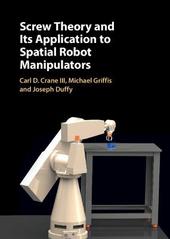
|
Screw Theory and its Application to Spatial Robot Manipulators
Hardback
Main Details
| Title |
Screw Theory and its Application to Spatial Robot Manipulators
|
| Authors and Contributors |
By (author) Carl D. Crane, III
|
|
By (author) Michael Griffis
|
|
By (author) Joseph Duffy
|
| Physical Properties |
| Format:Hardback | | Pages:238 | | Dimensions(mm): Height 250,Width 171 |
|
| ISBN/Barcode |
9780521630894
|
| Classifications | Dewey:629.892015169 |
|---|
| Audience | | Tertiary Education (US: College) | |
|---|
| Illustrations |
Worked examples or Exercises
|
|
Publishing Details |
| Publisher |
Cambridge University Press
|
| Imprint |
Cambridge University Press
|
| Publication Date |
15 September 2022 |
| Publication Country |
United Kingdom
|
Description
Discover a fresh take on classical screw theory and understand the geometry embedded within robots and mechanisms with this essential text. The book begins with a geometrical study of points, lines, and planes and slowly takes the reader toward a mastery of screw theory with some cutting-edge results, all while using only basic linear algebra and ordinary vectors. It features a discussion of the geometry of parallel and serial robot manipulators, in addition to the reciprocity of screws and a singularity study. All 41 essential screw systems are unveiled, establishing the possible freedom twists and constraint wrenches for a kinematic joint. Familiarizing the reader with screw geometry in order to study the statics and kinematics of robots and mechanisms, this is a perfect resource for engineers and graduate students.
Author Biography
Carl Crane is Professor in the Department of Mechanical and Aerospace Engineering at the University of Florida. He is a fellow of the ASME. Michael Griffis is Senior Lecturer at the University of Florida. Joseph Duffy was a great kinematician who passionately promoted screw theory. He was the Director of the Center for Intelligent Machines and Robotics at the University of Florida and a Graduate Research Professor, who taught screw theory. He received countless awards, including the ASME Machine Design Award in 2000.
|